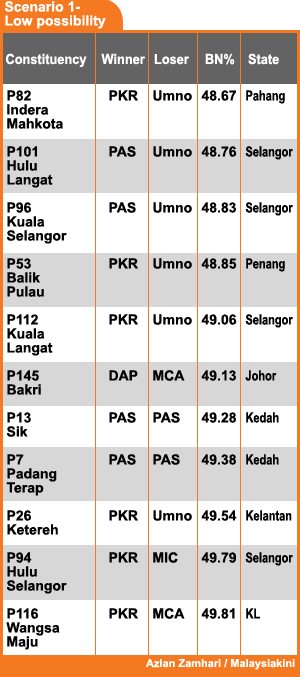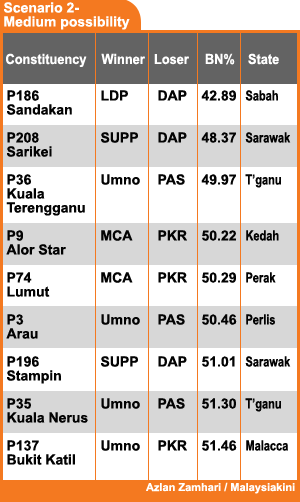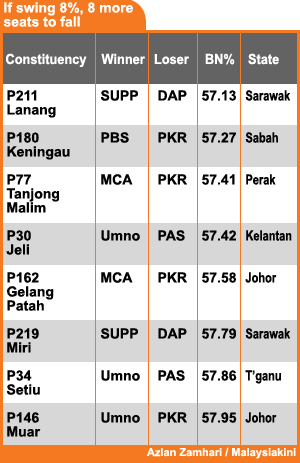By Chong Zhemin | 10:33AM Apr 4, 2013
Malaysiakini
Malaysiakini
The 13th general election will be the first election in history where Malaysians go to polls knowing that they have a chance to vote for a regime change.
There are three possible outcomes for the coming election:
Scenario 1 – BN regains two-thirds majority
Scenario 2 – Slight gain for Pakatan Rakyat
Scenario 3 – Pakatan wins the election
Scenario 2 – Slight gain for Pakatan Rakyat
Scenario 3 – Pakatan wins the election
Scenario 1 – Low possibility
For BN to regain two-thirds majority, BN would need to swing 1.5 percent of Pakatan voters in 2008.
 If BN succeeds in this, the coalition will add 11 parliamentary seats to the 140 seats won in 2008, giving them a total of 151 parliamentary seats with a comfortable two-thirds majority.
If BN succeeds in this, the coalition will add 11 parliamentary seats to the 140 seats won in 2008, giving them a total of 151 parliamentary seats with a comfortable two-thirds majority.
 If BN succeeds in this, the coalition will add 11 parliamentary seats to the 140 seats won in 2008, giving them a total of 151 parliamentary seats with a comfortable two-thirds majority.
If BN succeeds in this, the coalition will add 11 parliamentary seats to the 140 seats won in 2008, giving them a total of 151 parliamentary seats with a comfortable two-thirds majority.
However, this is unlikely given Chinese voters, which form a significant proportion of the electorate, are reportedly swinging heavily against BN.
[See chart - Scenario 1, left]
Scenario 2 – medium possibility
The second scenario has a medium possibility where the status quo is maintained, with Pakatan gaining an additional nine parliamentary seats.
If Pakatan could swing 1.5 percent of BN voters in 2008, Pakatan can add nine seats to the 82 seats they won in 2008. In total, Pakatan will win 91 parliamentary seats, 21 seats short of a simple majority.
[See chart - Scenario 2, below]

Scenario 3 – high possibility
The third scenario which has a high possibility is where Pakatan forms the next federal government.
In order for this to happen, Pakatan needs to overturn seven percent of BN voters in 2008.
Pakatan would be able to gain an additional 38 seats giving them a total of 120 parliamentary seats to form the next federal government.
[See chart - Scenario 3, below]
In order to overturn seven percent of votes for seats like Lubok Antu – (at the bottom of the list) where BN gets a popular vote of 56.75 percent – for every six Pakatan voters, one BN voter needs to be converted to vote for Pakatan in the coming election (seven percent out of 43 percent is roughly 1 to 6).
To put things into perspective, if every six Pakatan voters could convince one BN voter to vote for Pakatan in the coming election, the third scenario could become a reality.

Political barometer
An interesting side note would be the Gelang Patah seat, to be contested by DAP supremo Lim Kit Siang. If Pakatan is only able to swing seven percent of votes from BN, Lim Kit Siang will still lose in Gelang Patah.
However, if Pakatan is able to obtain a swing of an additional one percent, making it a total eight percent of the votes, Pakatan will be able to win eight more seats (including Gelang Patah) giving them a total of 128 seats – a very comfortable majority in the new government.
Hence the Gelang Patah parliamentary seat acts as the political barometer on whether Pakatan could form the next government.
 [See chart - If 8% swing, left]
[See chart - If 8% swing, left]
The above scenario is based on the following justifications:
- In 2008, the opposition parties did not form any electoral pact hence any cross-voting among the opposition parties in 2008 was limited.
- PM Najib Razak has already lost one of his trump cards – the timing of the election – and thus he was unable to take Pakatan by surprise. The opposition is ready for elections this time, unlike in 2008.
- The opposition poses a more credible challenge compared to 2008 as they are able to present an alternative budget and election manifesto.
- New voters traditionally favour the opposition.
- Internet penetration rate is higher than in 2008 making it easier for opposition parties to disseminate information. The opposition parties also have an upper hand in the social media war.
- The rise of civil society movements, in particular Himpunan Hijau and Bersih, will help the opposition to garner some fence-sitter votes.
Other factors
BN has provided freebies and cash handouts to the people, and these allow them to strengthen their current vote base in the rural areas which benefitted most from the cash handouts.
The urban voters still favour the opposition and are more interested in the reform agenda rolled out by Pakatan.
However there is a slight possibility that the semi-rural constituency will buy Najib’s transformation plan and swing back to BN, hence giving BN its much-vaunted two-thirds majority.
Najib’s delay in calling the election however shows his lack of confidence in getting back the two-thirds majority, validating the low possibility of this scenario from happening.
The above analysis is based on the 2008 election result without taking into account the three million new voters and transfer of voters from one constituency to another (for example the alleged transfer of 5,000 voters from Seputeh to Lembah Pantai).
Other factors that also need to be considered are the local issues and the strength of candidates.
Nevertheless, the above analysis provides an educated guess on the possible seats that will fall to either BN or Pakatan should there be a swing of votes in the 2013 general election.
CHONG ZHEMIN is a lecturer at a local university.
Source:
No comments:
Post a Comment